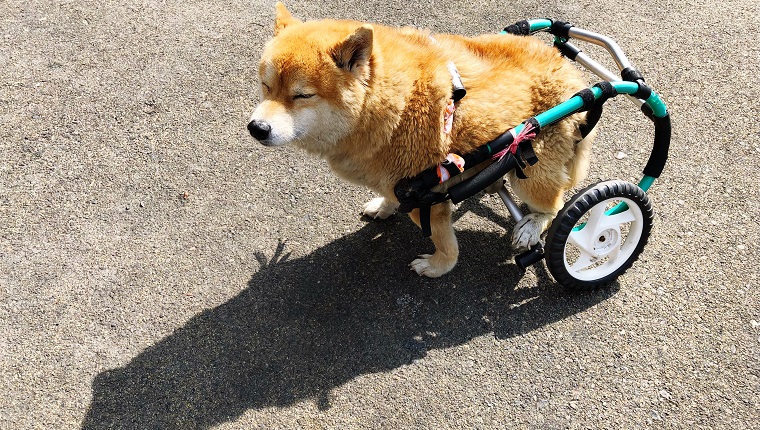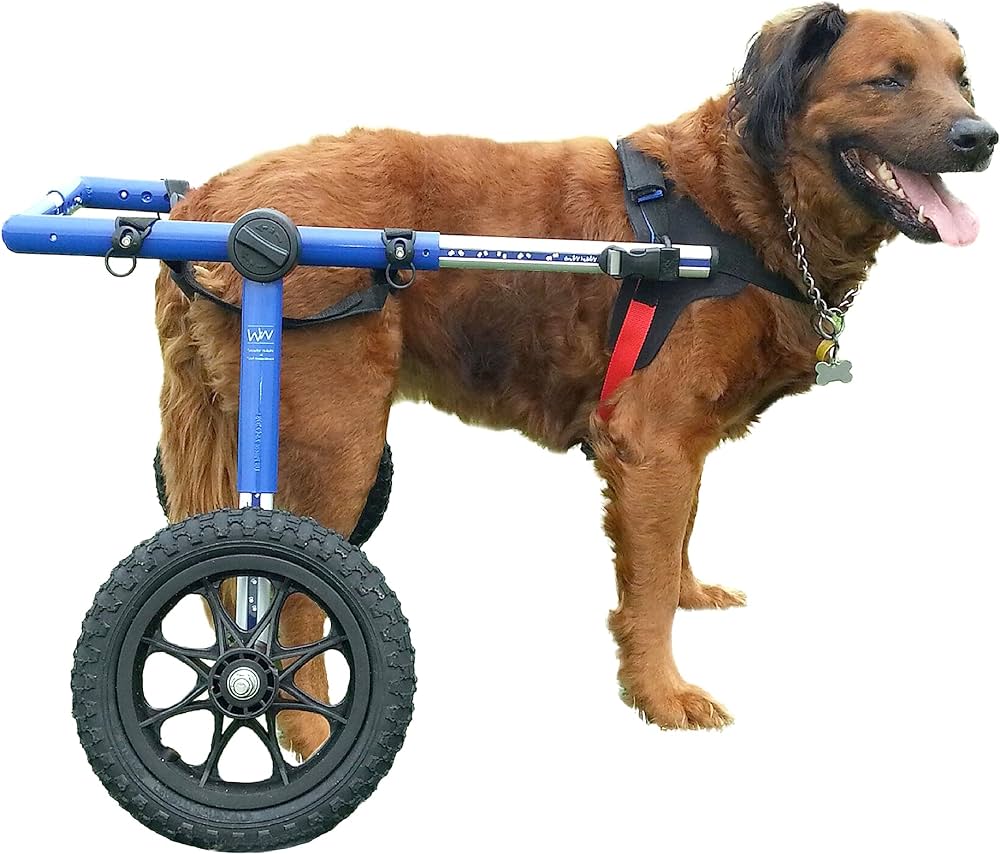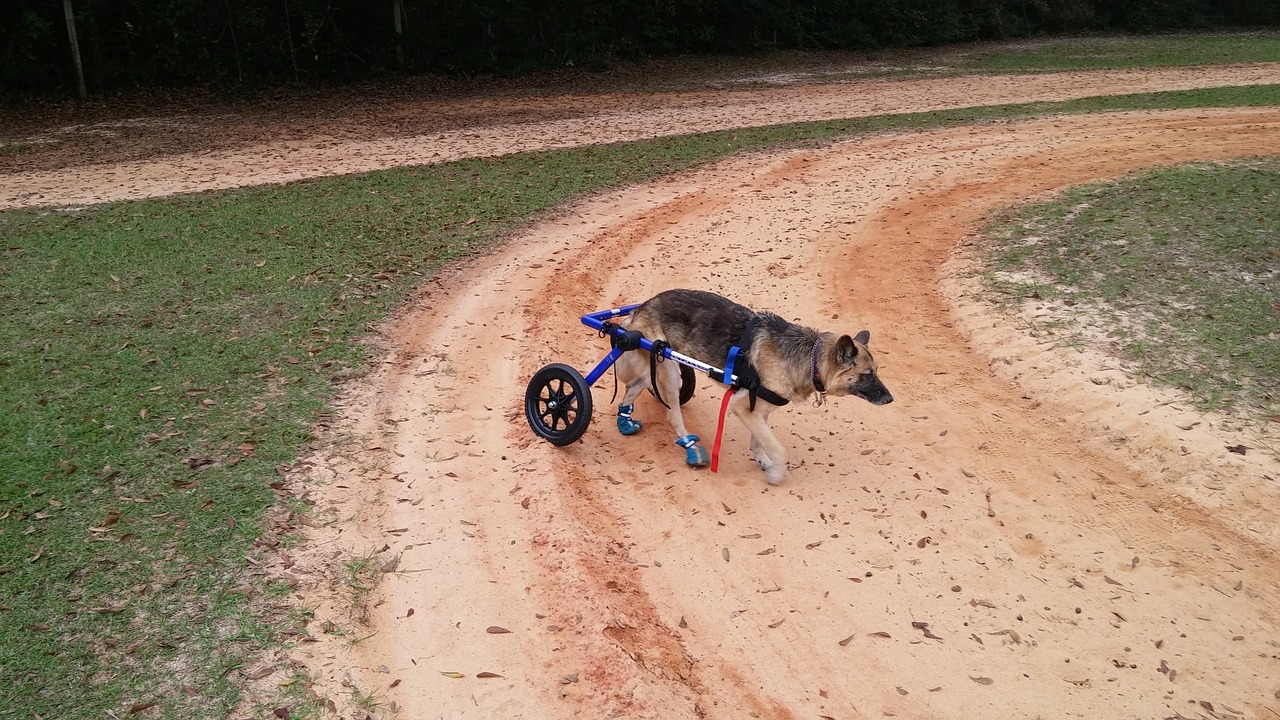If your furry friend is facing mobility issues or struggling with a disability, you may be wondering if vets would recommend dog wheelchairs as a solution. Rest assured, you’re not alone in pondering this question. In this article, we will explore the potential benefits of dog wheelchairs and provide you with valuable insight from veterinarians to help you make an informed decision for your beloved canine companion. So, let’s dive into the world of dog wheelchairs and discover if they come with the stamp of approval from the experts!
Benefits of Dog Wheelchairs
Improved Mobility
One of the major benefits of dog wheelchairs is the improved mobility they offer to dogs with mobility issues. Whether it’s due to old age, degenerative conditions, or injuries, some dogs may struggle to walk or get around on their own. A wheelchair can provide the necessary support and stability, allowing them to move freely and independently. With the help of a wheelchair, dogs can continue to enjoy their daily walks, explore their surroundings, and maintain an active lifestyle.
Relief from Pain
Another significant benefit of dog wheelchairs is the relief from pain they can provide. Dogs suffering from conditions such as arthritis, degenerative myelopathy, spinal injuries, or hip dysplasia often experience discomfort and pain while trying to move. Using a wheelchair can alleviate the pressure and strain on their affected limbs, joints, and muscles, reducing pain and improving their overall comfort level. By relieving pain, dog wheelchairs enable dogs to participate in activities they love without experiencing unnecessary discomfort.
Exercise and Mental Stimulation
Dog wheelchairs not only offer physical benefits but also contribute to the mental well-being of dogs. Regular exercise is crucial for maintaining a healthy weight and promoting good cardiovascular health in dogs. With a wheelchair, dogs can continue to engage in physical activities and exercise routines, which is important for their overall health and well-being. By providing the means for exercise, wheelchairs also help prevent obesity and related health issues. Additionally, continued physical activity can provide mental stimulation and prevent boredom, leading to happier and more contented dogs.
Conditions That May Require Dog Wheelchairs
Degenerative Myelopathy
Degenerative myelopathy is a progressive disease of the spinal cord that primarily affects older dogs. It leads to the loss of coordination and hindlimb weakness, often resulting in mobility difficulties. Dog wheelchairs can be extremely beneficial for dogs with degenerative myelopathy as they provide the necessary support to move their hind legs, enabling them to walk without stumbling or dragging their limbs.
Arthritis
Arthritis is a common condition in dogs, especially in older dogs or those with a history of joint injuries. It causes inflammation and stiffness in the joints, resulting in pain and decreased mobility. Dog wheelchairs can help relieve the pressure on arthritic joints, allowing dogs to move freely without discomfort. By reducing the strain on affected joints, wheelchairs enable arthritic dogs to maintain an active lifestyle and engage in physical activities with less pain.
Spinal Injuries
Spinal injuries can occur due to accidents, trauma, or degenerative conditions. They often lead to varying degrees of paralysis or reduced mobility in dogs. In such cases, dog wheelchairs provide the necessary support to the affected areas, allowing dogs to regain their mobility and independence. These wheelchairs are designed to support the spine and limbs, ensuring that dogs can move around comfortably and safely.
Hip Dysplasia
Hip dysplasia is a genetic condition that affects the hip joints in dogs. It causes the hip joints to develop abnormally, resulting in pain, lameness, and reduced mobility. Dog wheelchairs designed specifically for dogs with hip dysplasia provide support to the hips and hind limbs, allowing dogs to walk and run with greater ease. By reducing the strain on the affected joints, wheelchairs can significantly improve the quality of life for dogs with hip dysplasia.
Consulting with a Veterinarian
Importance of Professional Advice
When considering a dog wheelchair for your beloved furry friend, it is crucial to consult with a veterinarian. A veterinarian can assess your dog’s specific condition, conduct a thorough examination, and provide valuable guidance on whether a wheelchair is suitable and beneficial for your dog. They can also recommend the appropriate type of wheelchair based on your dog’s needs and physical condition. The professional advice of a veterinarian ensures that you make an informed decision regarding your dog’s mobility and overall well-being.
Determining Suitability
Every dog is unique, and what works for one dog may not work for another. A veterinarian can help determine the suitability of a dog wheelchair for your particular dog. They will consider factors such as the dog’s age, size, weight, overall health, and specific condition. Based on these factors, the veterinarian can determine whether a dog wheelchair will provide the necessary support and enhance your dog’s mobility.
Customization Options
Dog wheelchairs come in various sizes and designs to accommodate dogs of different breeds, sizes, and needs. A veterinarian can help assess the specific requirements of your dog and recommend customization options if necessary. These customization options may include adjustable frames, support harnesses, or additional padding for added comfort. By working with a veterinarian, you can ensure that the wheelchair is tailored to meet your dog’s specific needs and provide optimal support.
Different Types of Dog Wheelchairs
Rear Support Wheelchairs
Rear support wheelchairs are designed to support dogs with weakness or paralysis in their hind limbs. These wheelchairs have a frame that supports the rear end of the dog, allowing them to walk using their front legs while the rear legs are comfortably supported. Rear support wheelchairs are ideal for dogs with conditions such as degenerative myelopathy, spinal injuries, or hip dysplasia.
Full Support Wheelchairs
Full support wheelchairs are designed for dogs with weakness or paralysis in both their front and rear limbs. They provide comprehensive support for the entire body, allowing dogs to move around comfortably and independently. Full support wheelchairs are suitable for dogs with conditions such as spinal injuries or severe arthritis.
Front Support Wheelchairs
Front support wheelchairs are specifically designed to assist dogs with reduced mobility in their front limbs. They provide additional support and stability to the front legs, allowing dogs to walk more comfortably. Front support wheelchairs are often recommended for dogs with conditions such as arthritis or injuries to the front limbs.
Features to Consider
Size and Weight Capacity
When choosing a dog wheelchair, it is essential to consider the size and weight capacity of the wheelchair. The wheelchair should be appropriately sized to ensure a comfortable fit for your dog and provide adequate support. It is important to measure your dog’s height, length, and weight accurately to select the right size wheelchair. Additionally, check the weight capacity of the wheelchair to ensure it can support your dog’s weight without compromising its functionality.
Adjustability and Comfort
Dog wheelchairs should be adjustable to accommodate your dog’s individual needs and ensure a proper fit. Look for wheelchairs with adjustable frames, straps, and support harnesses that can be tailored to your dog’s size and specific condition. Consider the comfort features of the wheelchair, such as padding, cushioning, or orthopedic support, to ensure maximum comfort for your dog during use.
Ease of Use
Choose a dog wheelchair that is easy to assemble, disassemble, and adjust. The wheelchair should have user-friendly features that make it convenient for you to assist your dog in using it. Look for features such as quick-release buckles, adjustable straps, and intuitive adjustments to make the wheelchair user-friendly for both you and your dog.
Durability
Consider the durability of the dog wheelchair to ensure it can withstand regular use and provide long-lasting support for your dog. Look for wheelchairs made from sturdy materials such as aluminum or stainless steel, as they are more resistant to wear and tear. Additionally, check the quality of the wheels and other moving parts to ensure smooth operation and reliable performance.
Training and Adaptation
Introducing the Wheelchair
When introducing a dog wheelchair to your furry friend, it is important to do so gradually and patiently. Start by allowing your dog to sniff and explore the wheelchair in a familiar and comfortable environment. Encourage positive associations by offering treats and rewards near the wheelchair. Gradually progress to having your dog wear the wheelchair for short periods of time, making sure they feel secure and supported.
Teaching the Dog to Use It
Once your dog is accustomed to the wheelchair, it is time to start teaching them how to use it for mobility. Begin in a controlled environment with plenty of open space and use treats or toys to motivate your dog to walk or move with the wheelchair. Provide gentle guidance and praise to encourage your dog’s progress. It is important to be patient and understanding as your dog may take some time to adapt to the new way of moving.
Monitoring Progress
As your dog becomes more comfortable and proficient with the wheelchair, it is crucial to monitor their progress and make any necessary adjustments. Regularly check the fit of the wheelchair and ensure that it is still providing the necessary support and comfort. Observe your dog’s movements and behavior to ensure they are adapting well to the wheelchair and that there are no signs of discomfort or distress.
Lifestyle Changes
Exercise and Activity Modifications
With the assistance of a dog wheelchair, your furry friend can continue to enjoy exercise and physical activities. However, it is important to make certain modifications to accommodate their new mobility needs. Avoid activities that put excessive stress or strain on their limbs or joints. Opt for low-impact exercises such as swimming or gentle walks that allow your dog to maintain their fitness without causing discomfort.
Assisting with Bathroom Needs
When using a dog wheelchair, it is important to consider your dog’s bathroom needs and make necessary accommodations. Ensure that your dog has easy access to an appropriate area for relieving themselves. You may need to adjust the design or remove certain parts of the wheelchair to allow your dog to position themselves comfortably for elimination. Regularly check for any signs of urinary or fecal leakage and address any issues promptly.
Home Accessibility
Make necessary modifications to your home to ensure it is accessible and safe for your dog in the wheelchair. Clear any obstacles or clutter that may hinder your dog’s movement. Provide slip-resistant rugs or mats to prevent slips or falls. Consider installing ramps or lifts to help your dog navigate stairs or elevated surfaces. By creating a wheelchair-friendly environment, you can enhance your dog’s independence and ensure their safety within the home.
Potential Risks and Precautions
Pressure Sores and Skin Irritation
One potential risk with dog wheelchairs is the development of pressure sores or skin irritation. Continuous contact and rubbing against the wheelchair’s straps or frame can cause friction and pressure on the skin, leading to discomfort and potential skin issues. Regularly inspect your dog’s skin and the areas of contact with the wheelchair. Make sure the wheelchair is properly adjusted and fitted to minimize the risk of pressure sores. If any irritation or redness is noticed, provide appropriate padding or consult a veterinarian for further guidance.
Overexertion and Fatigue
While dog wheelchairs allow dogs to maintain their mobility and engage in physical activities, it is important to monitor their activity level to prevent overexertion and fatigue. Dogs may feel more energetic with the added support of a wheelchair and may attempt to push themselves too far. Pay close attention to your dog’s body language and behavior during exercise. Encourage short, frequent walks with breaks in between to prevent exhaustion and ensure your dog’s well-being.
Close Monitoring
It is vital to closely monitor your dog’s overall health and well-being when using a wheelchair. Regularly check for any signs of discomfort, pain, or changes in behavior that may indicate a need for adjustment or additional support. Ensure that the wheelchair remains in good condition and is functioning properly. Regular veterinary check-ups are essential to detect any changes in your dog’s condition and address any concerns promptly.
Other Mobility Aids
Harnesses and Slings
In addition to wheelchairs, harnesses and slings can be used to provide mobility support to dogs with specific needs. Harnesses can assist with front or rear limb support, depending on your dog’s condition. Slings can be used to help lift and support dogs with weakened limbs or mobility issues. These aids can be used in conjunction with a wheelchair or as an alternative in certain situations, providing additional options for supporting your dog’s mobility.
Orthopedic Beds and Ramps
Orthopedic beds and ramps can also contribute to your dog’s overall comfort and accessibility. Orthopedic beds offer added support and cushioning for dogs with joint pain or stiffness, providing a comfortable resting place. Ramps can help dogs with mobility challenges access elevated surfaces such as beds, sofas, or cars, reducing the need to jump or climb and minimizing the strain on their joints.
Physical Therapy
Physical therapy can be a valuable addition to your dog’s mobility regimen, especially in combination with a wheelchair. A professional therapist can develop a customized program to target specific muscle groups, improve range of motion, and enhance overall mobility. Physical therapy sessions can help strengthen your dog’s muscles, improve their coordination, and optimize their use of the wheelchair.
Testimonials from Pet Owners
Improved Quality of Life
Many pet owners have reported a significant improvement in their dog’s quality of life after using a wheelchair. Dogs who were previously immobile or struggled to walk have regained their independence and are once again able to explore their surroundings with enthusiasm. The ability to move freely not only improves physical health but also promotes mental well-being, leading to a happier and more fulfilled life for both the dog and their owner.
Positive Impact on the Bond
Using a dog wheelchair can have a positive impact on the bond between the dog and their owner. The wheelchair becomes a tool for shared experiences, as the owner assists and supports the dog in their mobility. This increased interaction and trust can deepen the bond between the two, creating a stronger and more meaningful connection. The loving care provided by the owner, coupled with the newfound mobility, can strengthen the emotional bond and create a sense of security for the dog.
Inspiration and Hope
The stories of dogs overcoming mobility challenges with the help of a wheelchair can inspire others facing similar situations. Seeing the resilience and determination of these dogs can instill hope in pet owners who may be initially discouraged by their dog’s condition. Wheelchairs provide an opportunity for dogs to continue to lead fulfilling lives, defying limitations and adapting to their new circumstances. The testimonials of pet owners who have experienced the positive impact of dog wheelchairs can provide encouragement and inspiration to others facing similar challenges.
In conclusion, dog wheelchairs offer numerous benefits for dogs with mobility issues. They provide improved mobility, relief from pain, exercise opportunities, and mental stimulation. Conditions such as degenerative myelopathy, arthritis, spinal injuries, and hip dysplasia may require the use of a wheelchair. Consulting with a veterinarian is crucial to determine suitability and explore customization options. There are different types of dog wheelchairs, each catering to specific needs. Consideration should be given to size, adjustability, comfort, ease of use, and durability when selecting a wheelchair. Training, adapting, and making lifestyle changes are important aspects of integrating a wheelchair into a dog’s life. It is important to be aware of potential risks and take necessary precautions, while also considering the use of other mobility aids such as harnesses, slings, orthopedic beds, ramps, and physical therapy. Testimonials from pet owners highlight the positive impact of dog wheelchairs on the quality of life, bond with their owners, and inspiration for others facing similar challenges. Overall, dog wheelchairs can significantly enhance the well-being and independence of dogs, ensuring they can continue to enjoy life to the fullest.



